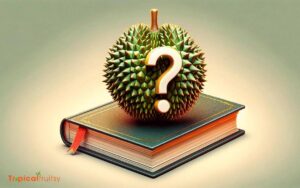When Is Durian Season in Bali? Unveiling the Ideal Season!
Durian season in Bali typically spans from November to February, with the potential for smaller yields extending to August.
The season’s timing can fluctuate slightly due to environmental factors, which underscores the importance of local insights for those eager to enjoy the freshest durians.
The durian fruit season in Bali is part of a broader pattern observed across Southeast Asia, where durians ripen in cycles.
The following points provide clarity on the seasonality:
Experience the king of fruits at its best during Bali’s durian season, a time for true tropical indulgence.
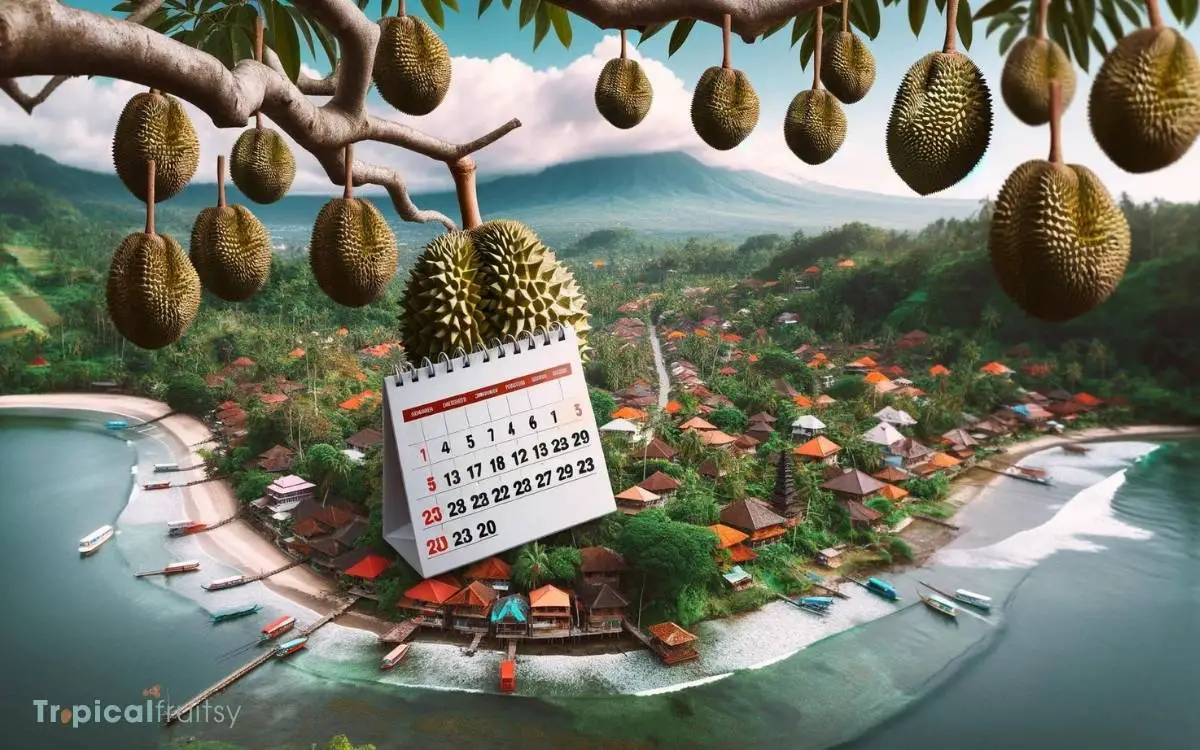
Key Takeaway
Durian Season in Bali: Peak Months and Availability
| Month | Durian Availability in Bali | Notes |
|---|---|---|
| November | High Availability | Start of the peak durian season |
| December | High Availability | Peak season continues |
| January | High Availability | Peak season in full swing |
| February | High Availability | End of the peak season |
| March to July | Moderate to Low Availability | Off-peak with sporadic availability |
| August | Possible Small Harvests | End of the extended season |
| September to October | Very Low to No Availability | Off-season for durians |
Understanding Durian Seasonality
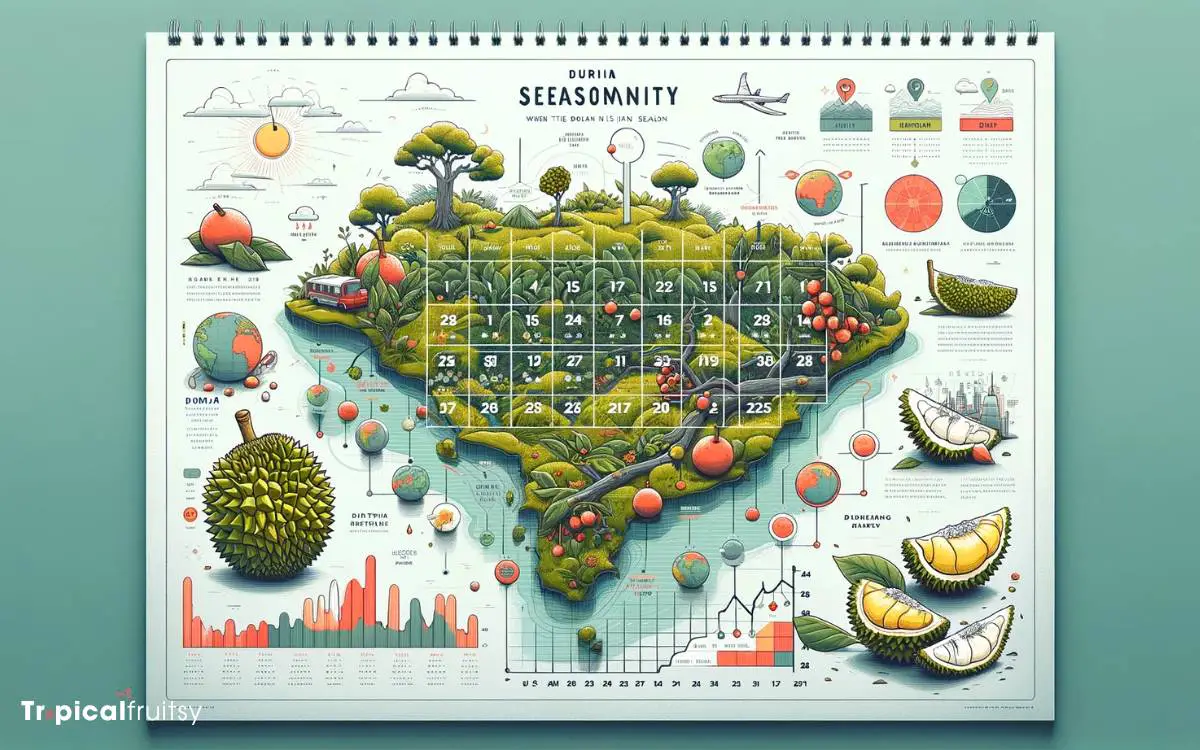
Bali’s durian season typically occurs during the months of December to March, when the island’s climate fosters the ideal conditions for this fruit to ripen.
The durian, known for its pungent aroma and distinctive taste, thrives in Bali’s wet season, which aligns with these months.
During this period, consistent rainfall and elevated humidity levels contribute to the maturation process, creating the perfect environment for durian trees to yield high-quality fruits.
This seasonality is not merely a matter of tradition but is underpinned by agricultural science, which dictates that durian trees require ample water and warm temperatures for optimal fruit development.
Consequently, understanding this cyclic pattern is essential for both cultivators and enthusiasts who seek to indulge in the freshest and most flavorful durians.
Bali’s Climate and Durian Growth
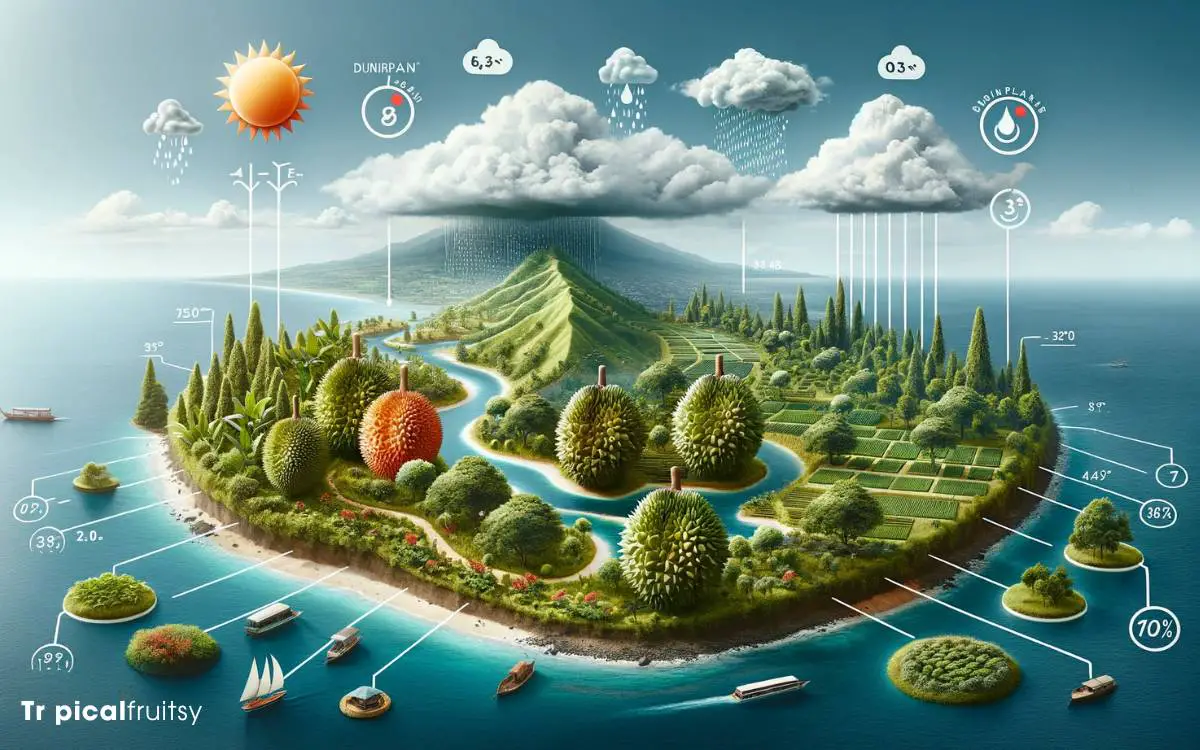
The tropical climate of Bali, characterized by high humidity and substantial rainfall, plays a pivotal role in the cultivation and growth of durian trees on the island.
These climatic conditions are integral to the durian life cycle, influencing not only the health of the trees but also the quality and flavor of the fruit produced.
To appreciate the intricate relationship between Bali’s climate and durian growth, consider the following points:
- Warm temperatures accelerate tree metabolism, enhancing growth and fruit production.
- High humidity levels are critical for flower and fruit set.
- Regular rainfall ensures sufficient water supply for optimal tree health.
- Seasonal climate variations dictate the timing of the durian harvest, marking the much-anticipated season for both locals and enthusiasts.
Prime Months for Durian Harvest
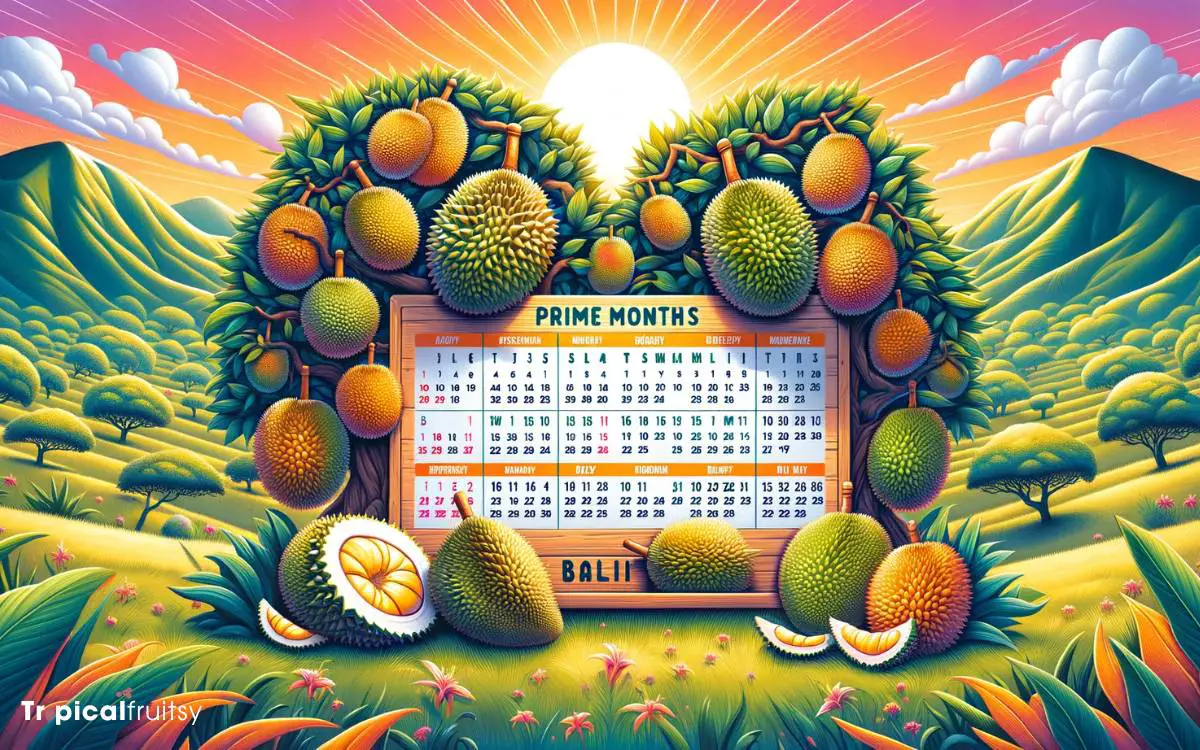
During the months of December to March, Bali experiences its peak durian season, when the fruits reach their optimal ripeness and are abundantly available across the island.
This period coincides with the wet season, when the increased rainfall provides the essential hydration that durian trees require for fruit development.
Agricultural analysis reveals that durian trees in Bali thrive under these specific climatic conditions, which contribute to the enhanced size, taste, and quality of the fruit.
The prime harvest months are critical for local farmers, as this is when the durian yield is at its highest, offering a bountiful supply to both local and international markets.
Connoisseurs and enthusiasts often regard this window as the optimal time to indulge in the distinctive flavor profile of Balinese durians, which are celebrated for their creamy texture and intense aroma.
Regional Variations in Bali
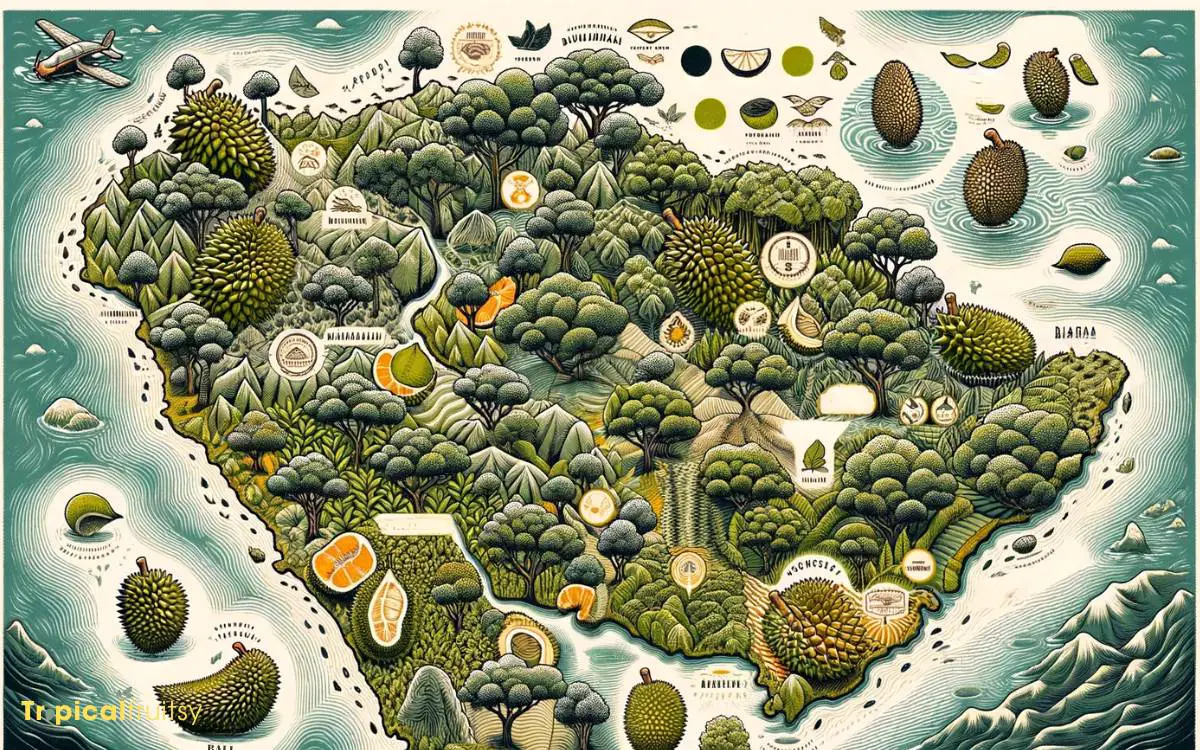
Within Bali’s diverse topography, durian season can exhibit slight regional variations that influence the precise timing of the fruit’s peak availability.
These variations are not merely incidental—they reflect the intricate dance between nature’s rhythms and the island’s unique climatic zones.
Consider the following regional distinctions:
- In the northern regions, durians often ripen later due to the slightly cooler microclimate.
- The central highlands experience a more distinct durian season, with clearer demarcations between peak and off-peak periods.
- Southern Bali, with its warmer, more consistent temperatures, may see a slightly earlier onset of the season.
- In the eastern parts, the season is heavily influenced by local rainfall patterns, which can accelerate or delay harvest times.
Each area’s durian season subtly tells the story of its environmental fingerprint, offering a nuanced understanding for enthusiasts and cultivators alike.
How to Identify Ripe Durians
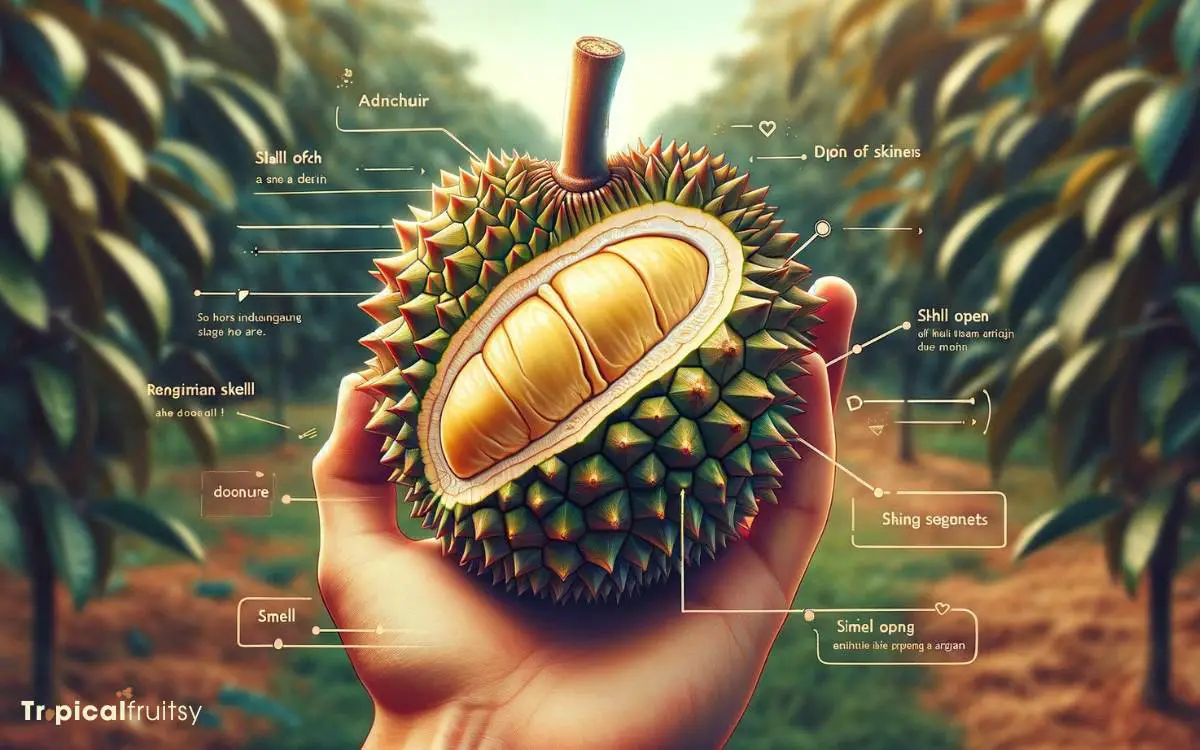
Bali’s durian aficionados know that identifying a ripe fruit is as much an art as it is a science, marked by specific sensory cues and physical characteristics.
A mature durian displays a slight give upon gentle pressure, indicating a supple, creamy flesh within. The stem appears dry and may exhibit cracks—a silent testament to the readiness of the fruit.
A distinct, pungent aroma, which can be polarizing, emanates from the durian, intensifying as it reaches peak ripeness.
For connoisseurs, the sound is telling; a subtle shake reveals a slight movement of seeds, suggesting the flesh has detached, a sure sign of maturity.
These indicators, honed by experience and observation, guide enthusiasts to the epitome of durian indulgence.
Best Places to Find Durian

Upon assessing the optimal locales for procuring durian in Bali, two primary sources stand out: local markets and dedicated durian farms.
Local markets offer the advantage of accessibility and variety, presenting an array of durians from different regions, often with knowledgeable vendors who can provide insights into the subtleties of flavor and ripeness.
In contrast, visits to durian farms afford a more immersive experience, allowing enthusiasts to witness the cultivation process and potentially sample freshly harvested fruits directly from the source.
Local Markets
Local markets in Bali offer a cornucopia of fresh produce, including durian, particularly during the peak season.
Discerning enthusiasts eager to experience the king of fruits can embark on a sensory journey, exploring vibrant stalls brimming with varieties of durian.
To optimize the quest for the finest durians, consider these curated locales:
- Badung Market: The pulsating heart of Denpasar’s trade, offering an extensive selection of durian.
- Kereneng Market: A bustling hub where the fragrance of ripe durian fills the air.
- Ubud Market: Renowned for high-quality, organic durian amidst the cultural tapestry of Bali.
- Jimbaran Market: A place where coastal freshness meets the creamy indulgence of durian.
Understanding the nuances of each market’s offerings is crucial for durian aficionados.
Durian Farms Visits
Exploration of durian farms in Bali reveals the peak season’s bounty, offering visitors a unique agricultural encounter with the island’s most controversial fruit.
Enthusiasts and the durian-curious alike can engage directly with growers, gaining insights into cultivation practices that underscore the fruit’s complexity and the skill required for its harvest.
| Farm Location | Best Time to Visit | Special Features |
|---|---|---|
| Tejakula, Buleleng | July – August | Organic, diverse varieties |
| Jatiluwih, Tabanan | August – September | Scenic terraced landscapes |
| Sidemen, Karangasem | August – October | Traditional farming methods |
| Mengwi, Badung | July – August | Farm tours and tastings |
These regions are not just top producers but are also known for their commitment to quality and sustainable farming, offering an immersive experience into the world of durian cultivation.
An analytical approach to farm selection, emphasizing factors such as climate, soil quality, and farming techniques, will reward visitors with the finest durian specimens.
Durian Etiquette and Tips
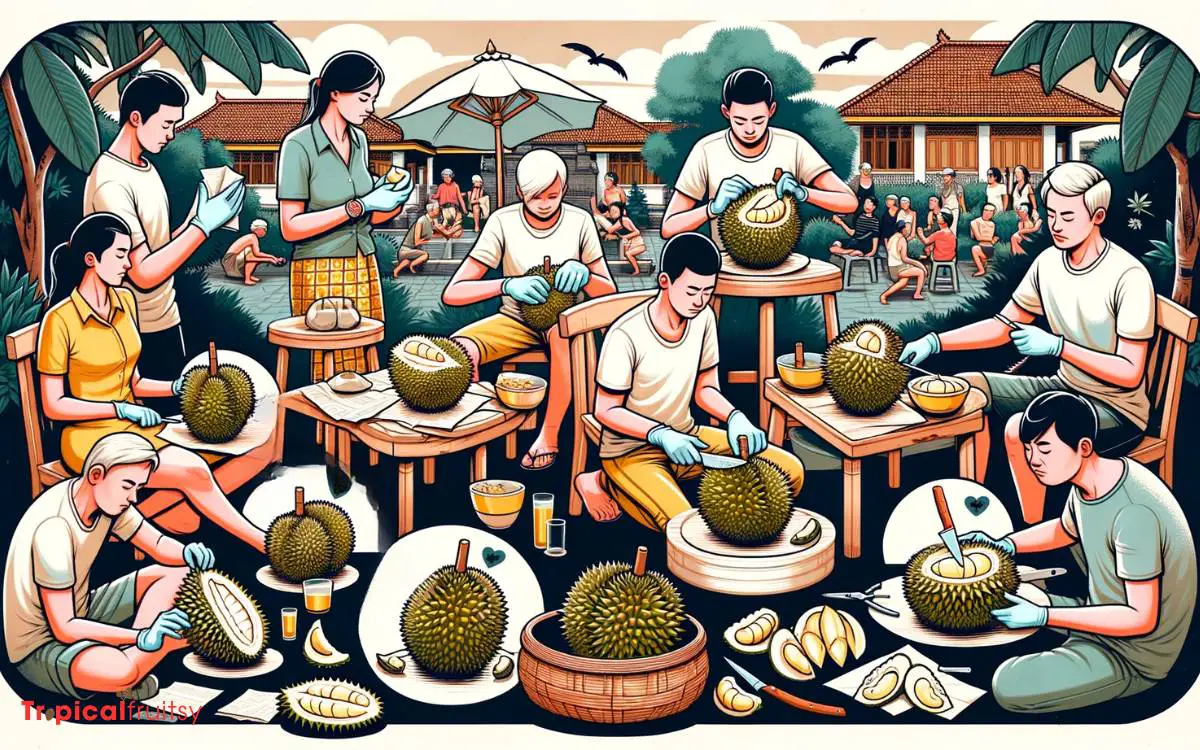
Understanding proper durian etiquette is essential for visitors wishing to enjoy this fruit in Bali during its peak season.
Durian, known as the ‘King of Fruits’, is not only celebrated for its taste but also comes with a set of cultural nuances that demand respect and understanding.
When indulging in durian, consider the following:
- Respect the Space: Enjoy durians in designated areas to avoid overwhelming non-appreciators with its potent aroma.
- Handle with Care: Use gloves or napkins to hold durian to prevent the strong smell from lingering on your hands.
- Dispose Responsibly: Place shells and remnants in provided receptacles to maintain cleanliness and order.
- Mind Others: Consume durian considerately, acknowledging that its pungent odor may not be pleasant for everyone in your vicinity.
Conclusion
In summary, Bali’s durian season reflects a symphony of natural factors, with prime harvesting months spanning from December to August. Local variations in climate contribute to these temporal shifts.
Connoisseurs can discern the fruit’s ripeness through sensory cues, and markets across the island become epicenters for durian procurement. Adherence to durian etiquette ensures an immersive cultural experience.
This cyclical phenomenon offers a unique window into Bali’s agricultural tapestry, where the king of fruits reigns supreme.






